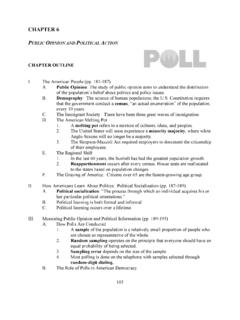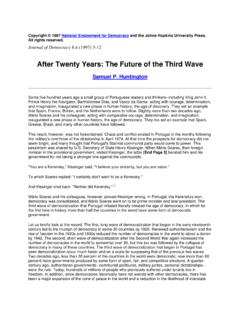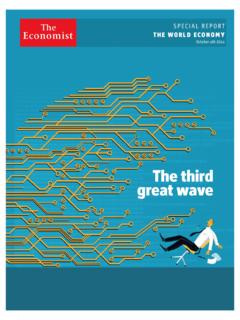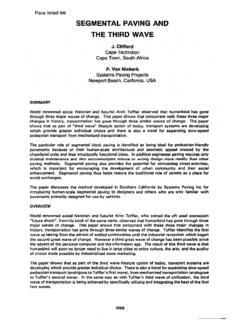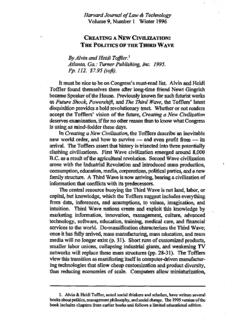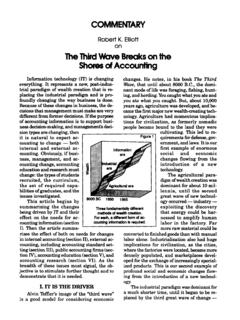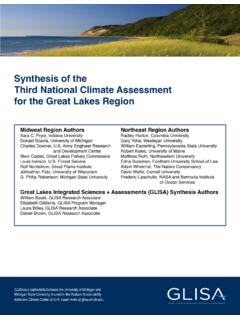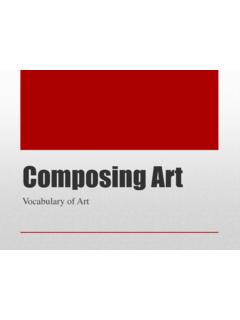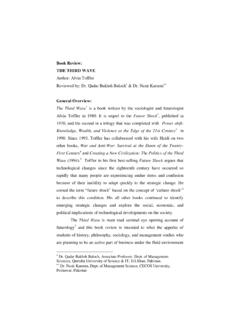Transcription of The Great Wave: Price Revolutions and the Rhythm of History
1 The Great Wave: Price Revolutions and the Rhythm of HistoryDavid Hackett FisherThe Cycles of History :Positive feedback self organizing to criticality, resulting in avalanchesAvalanches are not catastrophes, they are inherent in the behavior of complex systems; catastrophes have no meaning, they just areThe Great Wave: Price Revolutions and the Rhythm of HistoryWe found evidence of four Price - Revolutions since the twelfth century: four very long waves of rising prices, punctuated by long periods of comparative Price -equilibrium. This is not a cyclical pattern. Price Revolutions have no fixed and regular periodicity. Some were as short as eighty years; others as long as 180 years. They differed in duration, velocity, magnitude, and Great Wave: Price Revolutions and the Rhythm of HistoryThe first stageof every Price -revolution was marked by material progress, cultural confidence, and optimism for the future an equilibrium second stagewas very different.
2 It began when prices broke through the boundaries of the previous equilibrium. This tended to happen when other events intervened-commonly wars of ambition that arose from the hubris of the preceding period. These events sent prices surging up and down again, in a pattern that was both a symptom and a cause of instability. The consequences included political disorder, social disruption, and a growing mood of cultural Great Wave: Price Revolutions and the Rhythm of HistoryThe third stagebegan when people discovered the fact of Price -inflation as a long-term trend, and began to think of it as an inexorable condition. They responded to this discovery by making choices that drove prices still higher. A fourth stagebegan as this new institutionalized inflation took hold. Prices went higher, and became highly unstable.
3 They began to surge and decline in movements of increasing volatility. Severe Price shocks were felt in commodity movements. The money supply was alternately expanded and contracted. Financial markets became unstable. Government spending grew faster than revenue, and public debt increased at a rapid rate. In every Price -revolution, the strongest nation-states suffered severely from fiscal stresses. hoarding, Price gouging, cheating, Price fixing, Great Wave: Price Revolutions and the Rhythm of HistoryFinally, the Great wave crested and broke with shattering force, in a cultural crisis that included demographic contraction, economic collapse, political revolution, international war and social violence. These events relieved the pressures that had set the Price -revolution in motion.
4 The first result was a rapid fall of prices, rents and interest. This short but very sharp deflation was followed by an era of equilibrium that persisted for seventy or eighty years. Long-term inflation ceased. Prices stabilized, then declined further, and stabilized once more. Real wages began to rise, but returns to capital and land Great Wave: Price Revolutions and the Rhythm of HistoryThese material events had cultural consequences. In literature and the arts, the penultimate stage of every Price -revolution was an era of dark visions and restless dreams. This was a time of lost faith in institutions. It was also a period of desperate search for spiritual values. Sects and cults, often very angry and irrational, multiplied rapidly. Intellectuals turned furiously against their environing societies.
5 Young people, uncertain of both the future and the past, gave way to alienation and cultural s the System ..We tend to view cultural, economic, social, political, scientific, artistic, religious events as largely separate or only loosely lesson here is that when we says it s the system, what we mean is everything is connected with everything else by positive and negative feedback mechanisms, that are fractal, follow power-laws, and all the other universality principles of complex Medieval Price Revolution1180-1350 The First WaveThe Crisis of the Fourteenth CenturyMitteo Villani(contemporary witness of the plague) It was thought that people whom God by his grace in life had preserved .. Would become better, humble, virtuous, and catholic, avoiding inequities and sins and overflowing with love and charity for one another.
6 But .. The opposite happened. Men .. Gave themselves over to the most disordered and sordid behavior .. As they wallowed in idleness, their dissolution led them into the sin of gluttony, into banquets, taverns, delicate foods and gambling. They rushed headlong into lust. In: Hollis, Why Good People Do Bad Things, p 144As the web thickened, the Price -revolution came to be elaborately embedded in entire economic systems, and social conflicts began to grow. The Protestant Reformation and Catholic Counter-Reformation shattered the most important unifying institution in the Western world the Christian church. Religious conflicts of Great violence broke out ..The Equilibrium of the RenaissanceThe Second WaveThe Equilibrium of the RenaissanceThe Price Revolution of the Sixteenth CenturyThe Second WavecontinuedThe Crisis of the Seventeenth Century The general crisis of the seventeenth century left its mark uponthe culture of an age.
7 The greatest works of literature, painting, philosophy and theology in this era commonly express a mood of increasing pessimism and Bruegel The Fall of the Rebel Angels The general crisis of the seventeenth century left its mark uponthe culture of an age. The greatest works of literature, painting, philosophy and theology in this era commonly express a mood of increasing pessimism and despair. In theology this was the era of neo-Calvinism the narrowest, darkest, bleakest, and most pessimistic form of Christianity that has ever been invented. The crisis .. was marked by a revival of religious strife. Protestants and Catholics, became increasingly militant and uncompromising. The Equilibrium of the Enlightenment 1660-1730 the third WaveThe Price of Wheat in Three European CapitalsStaple Prices in America Many rulers were called Great in this era: Louis Le Grand, Frederick the Great Elector, Frederick the Great , Peter the Great , Catherine the Great .
8 These leaders were no more able than many of the failed monarchs who preceded them. But, an age of equilibrium is kind to reigning kings. A reputation for greatness in a monarch often owes more to circumstance than to character. The Price Revolution of the Eighteenth CenturyThe third WavecontinuedCommodity Prices in England, France, and the third Wave: Eighteenth Century Price RevolutionPrice Revolution Begins: the new trend started slowly and silently, in much the same manner as the Great waves that had preceded third Wave: Eighteenth Century Price Revolution The primer mover of this Price revolution was the increasing pressure of aggregate demand, caused by an acceleration in the growth of population. (p 123) After a long pause from 1660 to 1720 the population of England began to grow more rapidly during the late 1720s, at precisely the same moment when the Price -revolution started.
9 (p 124) Why did population grow .. ? In demographic terms, it happened mainly because of a decline in age at marriage and a small rise in rates of intramartial fertility (driven by improvements in material conditions). (p 124) Husbands and wives decided to have more children because the world appeared to have become a better place in which to raise a family. (p 125)PositiveFeedbackLoopThe third Wave: Eighteenth Century Price Revolution Governments responded to the Price -revolution with various fiscal expedients that were also inflationary. (p 128) As public spending tended to exceed income, the gap was filled with borrowing on a heroic scale. (p 128) So large was the French national debt ..that it spawned a capitalist class called rentiers.(p 128) Similar trends also occurred in Britain. (p 128)Both of which led to fiscal crises.
10 National debt rose to then unimaginable levels and consol (bond) values dropped. Whenever they did so, interest rates surged. (p 129)PositiveFeedbackLoopThe third Wave: Eighteenth Century Price Revolution As the Price -revolution continued, the rich and powerful generally did well for themselves. (p 130) The mid-eighteenth century was a golden age for country gentry and landowning elites. (p 130) In France farm rents doubled during the middle decades, .. And increased even more rapidly in many parts of Europe. (p 130) In England .. rents increased sharply during the Seven Years War, and kept on increasing thereafter. (p 130)PositiveFeedbackLoopThe third Wave: Eighteenth Century Price Revolution While rents and interest kept up with inflation, wages fell behind.. Real wages fell from as early as the 1730 s to the nineteenth century (p 132) Increasing population.
